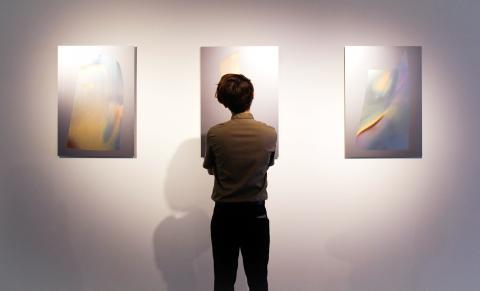After experiencing the Arctic’s midnight sun and polar nights, London-based artist Jessica Rayner found inspiration in the role of light in human life.
“This [experience] made me question what happens when our main source of light — the sun — isn’t available to us?” Rayner said via Skype at the launch of her Faces of Light exhibition at Taipei’s Bluerider Art Gallery on Saturday.
Her first solo exhibition in Asia is an attempt to answer that question.

Photo: Sofia Kuan
Light, darkness and color all work together in her collection to show how they shape the way we perceive ourselves and the world around us. Visitors on Saturday were mainly drawn to the diverse uses of dancing lights and hues in all the pieces, and the strong emotions these convey. Throughout all her works, Rayner uses inanimate objects like orbs, lenses, glass and prisms to capture images that are impossible to see with the naked eye.
The series Awareness of the Light shows Rayner’s ability to draw on the surrounding environment as a means to create art. Visitors to the gallery are welcomed by four aluminum canvases etched with what seems to be a dancing rainbow, but are, in fact, a large plastic Fresnel Lens, a kind of prism, hung in front of a window. She allowed it to dance as the sun’s rays broke through it, capturing a choreography of movement and color.
BEFORE NEWTON
Rayner also brings the viewer back in time with the Before Newton series. These are gray scale glass paintings that are meant to represent how people perceived objects and light before Newton’s discovery of the color spectrum.
The images are more jagged and geometrical in comparison to the rest of the works but they strongly suggest a time when concepts of light were more rigid.
“Everything has a history and story of process and that is something that I’m very interested in with my work,” Rayner said.
In her series Afterimage, Rayner experimented with the change of light throughout the day by photographing square prisms using a Polaroid camera and different filters. The resulting images are colorful yet unclear and off-focus, but purposely so.
Rayner said that her pieces are an attempt to communicate feelings and states of being that are open to interpretation rather than straightforward messages.
At a time when much of the media we consume is over processed and leaves little room for the imagination, it’s refreshing to encounter young artists like Rayner, who employ an abstract yet unpretentious approach.
“Nothing is objective, we are constantly evolving,” Rayner said. “I want [my art] to be more of a mood and an experience and the idea that we are in the midst of a long history. We are here just for a moment in time.”

In Taiwan there are two economies: the shiny high tech export economy epitomized by Taiwan Semiconductor Manufacturing Co (TSMC, 台積電) and its outsized effect on global supply chains, and the domestic economy, driven by construction and powered by flows of gravel, sand and government contracts. The latter supports the former: we can have an economy without TSMC, but we can’t have one without construction. The labor shortage has heavily impacted public construction in Taiwan. For example, the first phase of the MRT Wanda Line in Taipei, originally slated for next year, has been pushed back to 2027. The government

July 22 to July 28 The Love River’s (愛河) four-decade run as the host of Kaohsiung’s annual dragon boat races came to an abrupt end in 1971 — the once pristine waterway had become too polluted. The 1970 event was infamous for the putrid stench permeating the air, exacerbated by contestants splashing water and sludge onto the shore and even the onlookers. The relocation of the festivities officially marked the “death” of the river, whose condition had rapidly deteriorated during the previous decade. The myriad factories upstream were only partly to blame; as Kaohsiung’s population boomed in the 1960s, all household

Allegations of corruption against three heavyweight politicians from the three major parties are big in the news now. On Wednesday, prosecutors indicted Hsinchu County Commissioner Yang Wen-ke (楊文科) of the Chinese Nationalist Party (KMT), a judgment is expected this week in the case involving Hsinchu Mayor Ann Kao (高虹安) of the Taiwan People’s Party (TPP) and former deputy premier and Taoyuan Mayor Cheng Wen-tsan (鄭文燦) of the Democratic Progressive Party (DPP) is being held incommunicado in prison. Unlike the other two cases, Cheng’s case has generated considerable speculation, rumors, suspicions and conspiracy theories from both the pan-blue and pan-green camps.

Stepping inside Waley Art (水谷藝術) in Taipei’s historic Wanhua District (萬華區) one leaves the motorcycle growl and air-conditioner purr of the street and enters a very different sonic realm. Speakers hiss, machines whir and objects chime from all five floors of the shophouse-turned- contemporary art gallery (including the basement). “It’s a bit of a metaphor, the stacking of gallery floors is like the layering of sounds,” observes Australian conceptual artist Samuel Beilby, whose audio installation HZ & Machinic Paragenesis occupies the ground floor of the gallery space. He’s not wrong. Put ‘em in a Box (我們把它都裝在一個盒子裡), which runs until Aug. 18, invites